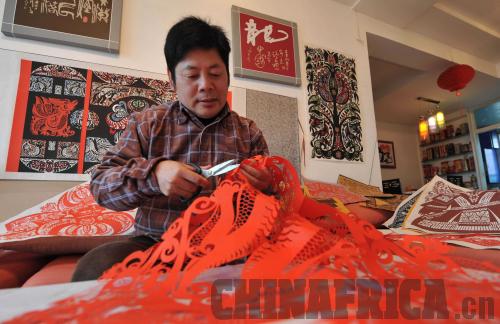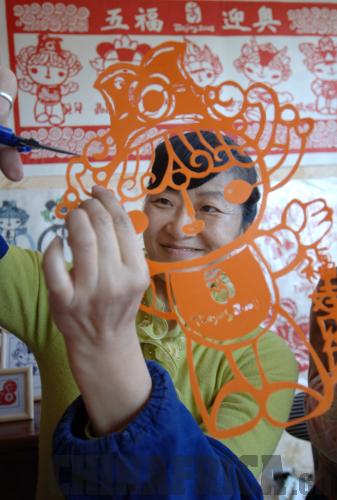| 
In 2012, Chinese artist Chen Yanrong was invited to teach paper cutting in Mauritius and Seychelles. Over the course of 11 days, she gave instruction to 75 African students who were eager to learn the exquisite art.
Like Chinese knotting and shadow puppets, paper cutting is a Chinese folk art that has become an iconic symbol of Chinese culture. The history of handmade paper-cuts may date back to when paper was invented. In the Han Dynasty (206 B.C.-220), the invention of paper contributed to the emergence, development and popularization of paper cutting, where it prevailed strongly in north China. Paper cutting is historically significant. Women and girls in rural areas usually practice the art. Traditionally, handicraft skills have been important criteria used to evaluate Chinese women, and paper cutting was seen as a skill that every girl needed to learn at an early age. In the past, these skills were the mark of a good bride. Girls received different paper cutting patterns from their elders or sisters, which depicted scenes in nature, or plants or animals that they were familiar with. Similar to African sculpture, many paper-cut designs featured exaggerated motifs with distinct characteristics and unique charm. But, interestingly, professional paper-cut artists, as in other professions, tended to be men. Men were the only people allowed to labor in workshops.
Paper-cuts were commonly used in religious ceremonies. In ancient times, paper-cuts depicting people and furniture were usually buried with the deceased or ignited on funeral pyres. This traditional custom is still practiced among some Chinese people living outside China. But in this modern era it is mainly employed for room decorations or given as gifts.
Apart from their ornamental function, paper-cuts gradually became an industry in China, helping many people – especially those with disabilities – to fulfill their dreams of employment. In the small county Huantai in Shandong Province, east China, paper cutting is an emerging industry that promotes the employment of people with disabilities. About 100 people have been trained by the local Disabled Persons' Federation, and are able to live off the earnings they make from their paper-cuts. Skilled practitioners earn about $80 monthly, which is a substantial income for this demographic. In northwestern Chinese provinces such as Ningxia Hui Autonomous Region, a great number of women are joining the paper cutting industry. This shift is greatly increasing women's incomes in rural areas.
Paper cutting has a presence on the world stage. During the Asian Games in 2010 in Guangzhou and the 2008 Beijing Olympic Games, it became known internationally as a kind of calling card of Chinese culture. The traditional art has captured the attention of many foreigners, and demand for paper-cut products is mounting, as was the case with Arab businessmen who attended the China-Arab States Economic and Trade Forum held in Ningxia in 2010. Sales agreements have also been reached with South Korea, Malaysia, and some Middle East countries.
During the 2010 Shanghai World Expo, a collection of paper-cuts at the African Joint Pavilion garnered praise from leading officials of many countries. The paper-cuts depicted 43 African exhibition areas. It not only had commemorative significance for the Expo but also reflected the characteristics of Chinese culture.
With this new international spotlight, more and more paper-cut artists like Chen Yanrong are traveling to Africa to teach their skills to others who are curious to learn. Asian art now blooms on the African continent.

|